|
of Another Star The nearest star is 4.3 light years away ... thats about 40 trillion kilometres. All we can see when we look in even the most powerful earthbound telescope is a dot of light. How can astrophysicists detect planets around stars, or any other information for that matter, when they look at a single light smear on a photograph? One way that scientists can determine that a planet is orbiting a distant star is to look for stars that wobble. The gravitational force that holds a planet in orbit around a star causes the star to move as the planet circles around it, and the movement is greater if the planet is more massive. Imagine two skaters on the ice, with a rope, and the heavier person tries to spin the other around in a circle at the end of the rope. Even if the lighter skater being spun is tiny, the person doing the spinning will move a little as he turns, due to the pull on the rope. Telecopes far apart on Earth can be used in pairs to take images of the same star at the same time; the images can be combined to simulate a telescope with a mirror the length of the distance between the two telescopes. This is called interferometry. This can also be done by taking photographs six months apart, so that the distance from one telescope to itself six months later is the full width of Earth's orbit around the sun! 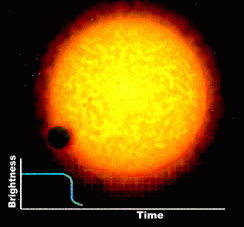
Another way that astronomers look for and study extrasolar planets is by watching stars, and noting periodic changes in their brightness. The changes are caused by the slight dimming of the star as a planet transits between it and us. This dimming is easily detectable. The Hubble telescope has given us images clearer that ever before, since there is no layer of atmosphere in the way. The Hubble telescope has been used to take direct pictures of nearby large stars, including the giant star Betelgeuse. Find out more here. By the end of 2022, the number of planets discovered orbiting other stars had grown to 5,235, alien worlds beyond our solar system. These include a diversity of distant planets including super-Earths, gas giants like Jupiter, 'ice giants' like Neptune, and small and rocky worlds that look a lot like Earth. It's likely there are over a trillion exoplanets in our Milky Way galaxy alone, and 4% of them probably Earth-like. The launch of the James Webb Space Telescope in December 2021 has helped the quest to discover more exoplanets. One of its other main goals is to study the life cycle of stars. Astronomers discovered the latest exoplanet in 2022, named HD 109833b. It is Neptune-like and orbits around a G-type star similar to our sun. The astronomers found it using the transit method. Another important tool an astrophysicist has is the spectrum of light from the star. The light is passed through a device much like a prism, and split into its component wavelengths. The wavelengths that exist in the light are a measure of what elements were undergoing fusion in the star. In addition, any cooler gasses in the upper layers of the star would absorb some of this light, and leave black lines in the spectrum where some wavelengths were absorbed, which will tell you something about the chemical makeup; every chemical element leaves a distinct pattern of absorption lines. But there's more. Anything that starlight passes through on its way to us will also filter out some of the light, and leave more black lines. The Hubble telescope examined the spectrum from the star HD 209458, a faint yellow star about 150 light years away. By looking at the absorption lines in the star's spectrum, particularly those for the element sodium, and noticing how they seemed to vary in intensity in a periodic way, astronomers determined that they were watching a planet with an atmosphere pass in front of the star! 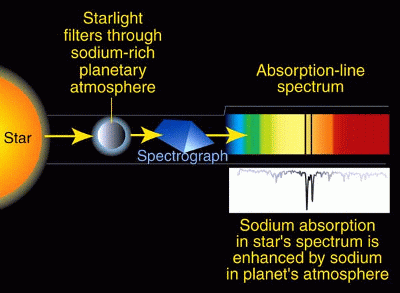 The planet itself was first discovered in 1999 through its slight gravitational tug on the star. The planet was estimated to be 70% the mass of Jupiter, a fairly large planet. Then astronomers determined that the tilt of the planet's orbit made it pass in front of the star from our viewpoint here on Earth. This planet became the 80th planet of another star to be discovered at that point. As the planet passes in front of the star, as described above, it causes the star to dim very slightly for the duration of the transit. Observations by the Hubble telescope revealed that the planet is mainly gaseous, rather than liquid or solid, meaning that the planet is a gas giant like Jupiter and Saturn. 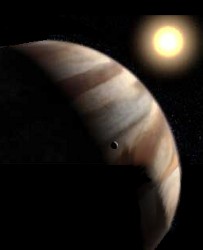 At the right is an artist's conception of that the planet might look like as it orbits star HD 209458. It apparently orbits the star at a very close distance, some 4 million miles, as compared to tiny Earth's distance from our sun of 93 million miles. 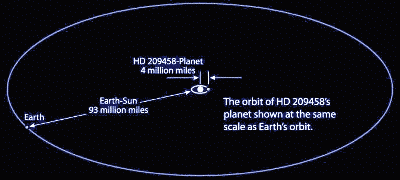 With some very careful measurements, scientists were also able to determine that the planet has an atmosphere. They did this by carefully analyzing the spectrum: here is a diagram which explains the process. 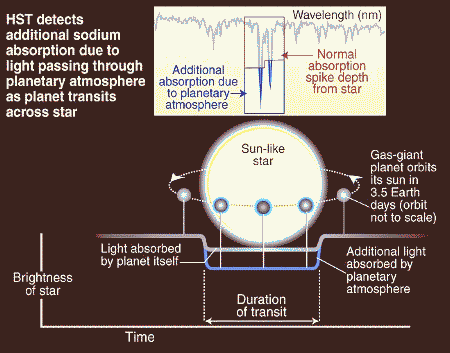 HTML, graphics & design by Bill Willis 2023 |